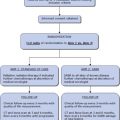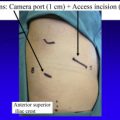In the absence of distant metastases, lung cancer treatment is determined by the results of mediastinal lymph node staging. Occult mediastinal lymph node metastases can be missed by radiologic and needle-based staging methods. Aggressive staging of mediastinal lymph nodes improves staging accuracy. Improved accuracy of mediastinal lymph node staging results in more appropriate lung cancer treatment. Improved accuracy of mediastinal lymph node staging can improve stage-specific survival from lung cancer.
Key points
- •
In the absence of distant metastases, lung cancer treatment is determined by the results of mediastinal lymph node staging.
- •
Occult mediastinal lymph node metastases can be missed by radiologic and needle-based staging methods.
- •
Aggressive staging of mediastinal lymph nodes improves staging accuracy.
- •
Improved accuracy of mediastinal lymph node staging results in more appropriate lung cancer treatment.
- •
Improved accuracy of mediastinal lymph node staging can improve stage-specific survival from lung cancer.
Importance of pretreatment staging in the management of non–small cell lung cancer
Despite advances in the treatment of non–small cell lung cancer, overall cure rates remain low. Only a relatively small proportion of patients with non–small cell lung cancer is diagnosed at an early stage; most are diagnosed only after there has been spread beyond the lung. The optimal treatment of non–small cell lung cancer is stage specific. Aggressive pretreatment staging efforts often lead to “upstaging,” which, in turn, results in improved stage-specific survival.
In staging patients with non–small cell lung cancer, the initial goal is to rule out distant metastatic disease. For practical reasons, this is accomplished primarily via imaging studies. As a rule, these include whole-body PET/computed tomography (CT) as well as brain MRI scans. Typically, suspected sites of distant metastatic disease may be confirmed using image-guided percutaneous needle biopsy techniques.
After excluding distant metastatic disease in the most feasible way, it is critical to rule out regional spread of tumor to the mediastinum. It has long been known that involvement of mediastinal lymph nodes greatly decreases the likelihood of cure using local treatment modalities (eg, radiotherapy or surgical resection) alone. The presence of mediastinal lymph node metastases makes control of systemic disease the priority, and chemoradiotherapy the mainstay of treatment, relegating surgical resection or stereotactic radiosurgical ablation to “adjuvant” treatment status.
Importance of pretreatment staging in the management of non–small cell lung cancer
Despite advances in the treatment of non–small cell lung cancer, overall cure rates remain low. Only a relatively small proportion of patients with non–small cell lung cancer is diagnosed at an early stage; most are diagnosed only after there has been spread beyond the lung. The optimal treatment of non–small cell lung cancer is stage specific. Aggressive pretreatment staging efforts often lead to “upstaging,” which, in turn, results in improved stage-specific survival.
In staging patients with non–small cell lung cancer, the initial goal is to rule out distant metastatic disease. For practical reasons, this is accomplished primarily via imaging studies. As a rule, these include whole-body PET/computed tomography (CT) as well as brain MRI scans. Typically, suspected sites of distant metastatic disease may be confirmed using image-guided percutaneous needle biopsy techniques.
After excluding distant metastatic disease in the most feasible way, it is critical to rule out regional spread of tumor to the mediastinum. It has long been known that involvement of mediastinal lymph nodes greatly decreases the likelihood of cure using local treatment modalities (eg, radiotherapy or surgical resection) alone. The presence of mediastinal lymph node metastases makes control of systemic disease the priority, and chemoradiotherapy the mainstay of treatment, relegating surgical resection or stereotactic radiosurgical ablation to “adjuvant” treatment status.
The timing of mediastinal lymph node staging
By definition, in non–small cell lung cancer, involvement of mediastinal lymph nodes with metastatic tumor is considered stage III and is associated with a worsened prognosis. In the absence of local symptoms, the focus of treatment for stage III non–small cell lung cancer shifts from local control of the primary tumor to systemic control, that is, the successful eradication of suspected occult micrometastatic disease. The addition of effective locoregional disease control may result in cure.
In patients with mediastinal lymph node involvement, surgical resection of non–small cell lung cancer is unlikely to result in a cure. Preferred treatment involves the use of systemic chemotherapy as well as external beam radiotherapy to the primary tumor and involved mediastinal nodes. Although chemotherapy and radiotherapy are more easily tolerated when used sequentially, concurrent chemoradiotherapy results in improved patient outcomes with a greater likelihood of cure. Survival of patients in whom unexpected mediastinal lymph node involvement is discovered at the time of surgical resection is somewhat improved with the addition of postoperative radiotherapy and chemotherapy.
In selected patients, the addition of adjuvant surgical resection following chemoradiotherapy for stage III non–small cell lung cancer has resulted in improved survival and higher cure rates. The highest rates of cure in mediastinal lymph node–positive stage III non–small cell lung cancer are observed in patients who undergo surgical resection following preoperative concurrent chemoradiotherapy and who are found to have achieved effective eradication of metastatic tumor from their mediastinal lymph nodes and a pathologic complete response of their primary tumor to preoperative chemoradiotherapy.
For medically fit patients with stage III non–small cell lung cancer with mediastinal lymph node involvement, survival is maximized by trimodality therapy that combines chemotherapy, locoregional radiotherapy, and surgical resection. Although postoperative radiotherapy improves the prognosis of patients whose mediastinal lymph node involvement is discovered unexpectedly at the time of surgical resection, the chance of cure is highest in patients who undergo surgical resection following successfully “downstaging” with preoperative/neoadjuvant chemoradiotherapy. Patients who are not successfully “downstaged” by preoperative/neoadjuvant chemoradiotherapy have a poor prognosis that is not improved by surgical resection. In view of the above, the optimal time to identify mediastinal lymph node involvement is before a treatment plan is made rather than intraoperatively or postoperatively. The most recent report of using trimodality in the neoadjuvant setting was by Suntharalingam and colleagues in 2012. Radiation Therapy Oncology Group (RTOG) 0229 was a prospective phase 2 study that looked for the effect of neoadjuvant chemoradiation on mediastinal lymph nodes, survival, and patterns of recurrence. Using weekly carboplatin/paclitaxel and concurrent radiotherapy 61.2 Gy, mediastinal nodal clearance was accomplished in 63% with relatively minimal morbidity and only one postoperative grade 5 toxicity.
Consequences of missed mediastinal lymph node involvement
Because of understaging, patients with unrecognized mediastinal lymph node involvement are likely to be offered inadequate therapy for their lung cancer. Typically, a failure to identify mediastinal lymph node metastases results in inappropriate surgical resection or stereotactic radiosurgical ablation of the primary lesion without any attention to control of the mediastinal disease and without adequate systemic chemotherapy. Patients who are undertreated for their lung cancer in this fashion are likely to experience either regional or distant “recurrence” of their disease. Because their cancer was treated inadequately in the first place, newly identified sites of disease in these patients actually represent disease progression rather than recurrence. In any case, patients with potentially curable lung cancer who are understaged and undertreated are more likely to die of disease progression.
When mediastinal nodal involvement is unrecognized before a primary lung cancer is removed, there is still an opportunity to discover lymph node metastases by adding mediastinal lymph node dissection at the time of lung resection. This discovery is likely to prompt postoperative adjuvant radiotherapy and systemic chemotherapy. Although such a discovery “after the fact” can lead to more correct staging, the benefits of postoperative radiotherapy are not as great as the benefits of neoadjuvant treatment with preoperative downstaging of disease. The patients who are most likely to benefit from resection of their stage III non–small cell lung cancer are those who have been successfully downstaged preoperatively with neoadjuvant treatment.
The benefit of resecting the primary tumor in the face of mediastinal lymph node involvement with non–small cell lung cancer is relatively low. When mediastinal lymph node involvement persists following neoadjuvant treatment, the prognosis is even worse. There is a significant possibility that offering resection of the primary tumor to patients with active mediastinal lymph node involvement might not be beneficial. Moreover, there is a high probability that such a surgical undertaking is likely to delay the onset of more helpful systemic chemotherapy. In the presence of active mediastinal lymph node metastasis, resection of the primary lung tumor should probably be avoided.
Benefits of preoperative detection of mediastinal lymph node involvement
The discovery of mediastinal lymph node metastases in patients with non–small cell lung cancer allows potentially futile lung resection to be avoided and affords an opportunity for needed chemoradiotherapy to be instituted in a timely fashion. Even microscopic involvement of mediastinal lymph nodes with metastatic tumor is associated with a worse prognosis. One of the best predictors of long-term survival following surgical resection for stage IIIA non–small cell lung cancer is complete clearance of mediastinal lymph nodes with neoadjuvant treatment. Patients with the least tumor burden in their mediastinal lymph nodes at the time of diagnosis are most likely to experience successful downstaging with neoadjuvant treatment and are most likely to become suitable candidates for adjuvant surgical resection of their primary lung cancer.
The ideal method for pretreatment mediastinal lymph node staging
In order to achieve the maximum benefit, staging of mediastinal lymph nodes should be undertaken before a treatment plan is made in all patients in whom distant metastatic disease has been excluded. Ideally, mediastinal lymph node staging should be readily and rapidly available, well-tolerated, and relatively noninvasive, safe, inexpensive, and highly reliable. Multiple methods of mediastinal lymph node staging are currently in use. These methods vary in their availability, invasiveness, safety, cost, and reliability. Because the importance of their involvement with metastatic tumor was first recognized, the optimal manner in which to evaluate mediastinal lymph nodes in patients with non–small cell lung cancer has been fiercely debated.
In evaluating the usefulness of any method of mediastinal lymph node staging, it is important to consider sensitivity and specificity. The sensitivity and specificity of any given staging method determine its usefulness in managing a population of patients. With respect to decision-making in an individual patient, however, it is far more relevant to consider the positive predictive value and the negative predictive value. In particular, the higher the negative predictive value of a staging method, the more reliable it is for excluding mediastinal lymph node involvement in a particular patient.
Noninvasive methods of mediastinal lymph node staging
Imaging studies can be used to detect the presence of mediastinal lymphadenopathy. CT has been used alone or in combination with PET. CT scanning is widely available and is relatively inexpensive. CT imaging of mediastinal lymph nodes is best achieved with the addition of intravenous contrast in order to better distinguish vascular structures from lymph nodes and other mediastinal tissue. The use of intravenous contrast may be limited by contrast allergy or impairment of renal function.
The use of CT alone for mediastinal lymph node staging in non–small cell lung cancer relies on abnormal enlargement of the mediastinal lymph nodes as a marker for tumor involvement. Mediastinal lymph node enlargement is not always associated with involvement by metastatic tumor. Conversely, involvement with metastatic tumor is not always associated with mediastinal lymph node enlargement. As a result, the use of CT alone for mediastinal lymph node staging is inaccurate.
Currently, pretreatment staging of non–small cell lung cancer with PET/CT is becoming a standard of care. Although PET/CT can be helpful in identifying unsuspected sites of distant metastatic disease, its usefulness in the pretreatment evaluation of mediastinal lymph nodes is limited. PET/CT imaging measures uptake of fludeoxyglucose (FDG); this uptake is determined by metabolic activity and is only an indirect indicator of tumor. Moreover, a critical mass of active tumor must be present before abnormal FDG uptake can be detected. As a result, PET/CT for detection of mediastinal lymph node involvement with non–small cell lung cancer is fraught with false positive and false negative results.
Stay updated, free articles. Join our Telegram channel

Full access? Get Clinical Tree







